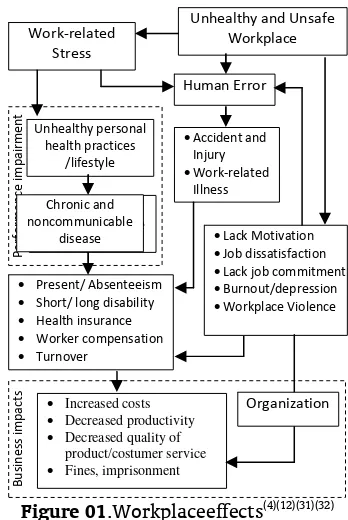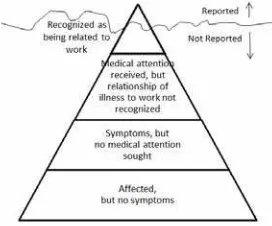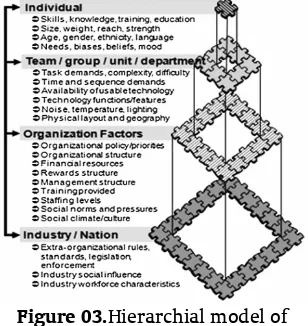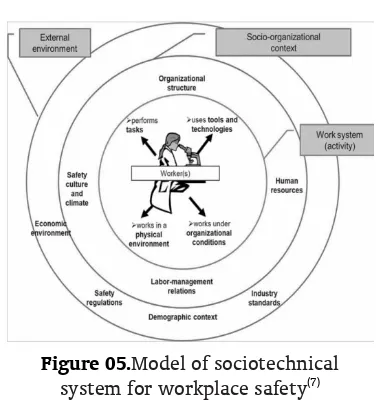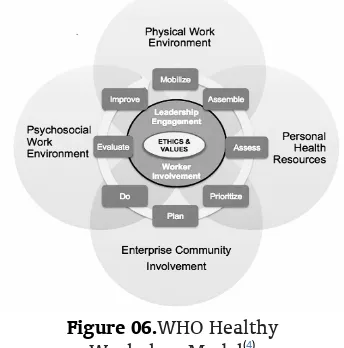MACROERGONOMICS FOR INTEGRATED
PUBLIC HEALTH AND SAFETY
Rani AuliaImran1, Iftikar Z. Sutalaksana2
Program Studi Magister TeknikdanManajemenIndustri, Institut Teknologi Bandung, Indonesia1
Lab. RekayasaSistemKerjadanErgonomi, KelompokKeilmuanManajemenIndustri,
InstitutTeknologi Bandung, Jln. Ganesha No. 10, Bandung2
Email:raniauran14@gmail.com, siftikar@y7mail.com
Abstract
Companies need manpower that has a certain ability to support their business processes. On the other hand, the manpower has needs that must be met to establish their economic life. The relationship between a company and the manpower is a mutually beneficial, if the ability of workers that supplied by the community in accordance as the company expected. But sometimes there are communities that have varying capabilities, those in terms of skill, knowledge, or attitude (SKA). Lack of adequate manpower will have impacts on the company; one of them is safety and health issue.
More than 50% citizens of Indonesia as workers, with the number of work accidents nationwide are high at 103,000 each year; which resulted death, disability or occupational diseases. Increases number of accidents, the greater the losses materially, time-loss, and declining productivity of a company. Accidents from 2011-2014 was recorded;only 51.14% of cases workers can recover after workplace accidents. Unrecovered workers became dependents, unproductive and require social support because they can no longer work due to disability or illness caused by work. For the community, these facts imply that the company does not bring benefits to the fullest.
In macroergonomics, the interaction between manpower, technology, working environment and its interaction with the community will be assessed.This paper uses this approach to designs an entire system to accommodate human performance capability in all its aspects, and to provide solutions to solve the problems mentioned above by conducting a literature review and create a conceptual framework.
Keywords: macroergonomics, public health, safety, human well-being.
A. Introduction
Workplaceor company has an impacton the community, generallyeasyto seeare theimpact
totheir economics and society1 With
theem-ployment, as a community memberthosewho became workers, have a sourceof income and economic support of their household. This makes the economic capacityof theworkerscan improvetheir socialstatusin the society. The relationship between a company and the manpower is a mutually beneficial, if the ability of workersthat supplied by the community is accordance as the company expected. But sometimes there are communities that have
varying capabilities, those in terms of skill, knowledge or attitude.
Other important impact ofa workplace and sometimes under estimated is the impacton the
health, physical or mental, ofthe workers2,3,17.
Work is an economic activity but also health matters, because occupational injury and illness
are part of the work 8.There is evidence that
companies are experiencing increased societal pressure to take on public responsibilities and are rapidly increasing their efforts to respond to
health of workers 3. To accomplish this goal,
organizations seeing this as an opportunity, not a burden 3,27.
More than 50% citizens of Indonesia asworkers, with the number of work accidents nation wide are high at 103,000 each year; which resulted death, disability or occupational
diseases9. Increases number of accidents, the
greater the losses materially, time-loss, and declining productivity of a company. Accidents from 2011 to 2014 was recordedevery semester
28;51,14% of workers fully recover, 44,50%
cannot work temporally, 3,12% impaired, and 1,32% died after an accident.Almost 47,63% of workers, not to mention their family, became dependents, unproductive and require social support because theycan no longer work due to disability or illness caused by work.For the community, these facts imply that the company does not bring benefits to the fullest.
Table 01. Capability and Willingness
Willing Not Willing
Capable
- Productive
- Less productive
- Can be productive
- Less productive
- Not productive
Not
- Less productive
- Not productive
Individual factors that substantial influence success as workers are the skills, knowledge and
attitude (31)(32). And as seen in Table 01,capability
summarizes the skills and knowledge, and willingness summarizes the attitude.If someonehas urge or motivation towork, thentheycan beproductive, less orunproductivedepending onthe capabilities theypossessed.This capability differences not only the level of education, but can be caused byimpaired physical, mental or well-being. Therefore, if someone do not have capability and do not have urge to work, they became dependent in the community.
C. Results and Discussion
1. Healthy Workplace
Public health is concerned with protection of the entire community from illness and the prevention of disease. This concernwould certainly include the millions of peoplewho go to work in a company, small or large
businesses(13).It is quite apparent that work can,
and does, influence health (1)(3)(5).Over the past
several decades, WHO definitions of a healthy workplace have evolved greatly; from an exclusive focus on the physical work environment (traditional approach of occupational health and safety: directinteraction with physical, chemical, biological and ergonomic hazards), and broadened to include health practice factors (lifestyle);psychosocial factors (work organization and workplace culture); andinterrelation to the community; all of which can have a great effect on worker’s health(4)(17)(32).
Factors Affects the Health ofWorkers
Figure 01.Workplaceeffects(4)(12)(31)(32)
WHO estimated, out of the two million estimated deathsfrom occupational injuries and illnesses, in 1998approximately 346,000 were due to traumaticworkplace injuries. Protecting health by removing hazards in the workplace, and thus avoiding disease, does notguarantee
Per
•Job dissatisfaction
•Lack job commitment
• Burnout/depression
•Workplace Violence
• Present/ Absenteeism
• Short/ long disability
• Health insurance
• Worker compensation
• Turnover
• Increased costs • Decreased productivity • Decreased quality of
product/costumer service • Fines, imprisonment
Organization Unhealthy and Unsafe
that workers will experience a goodhealth. A worker’s health is also influencedby his or her
personal health practices (4).
Mind and body are one, and what affects one inevitably affects the other. Sometimes non-physical or psychosocial hazards in the workplace can also affect physical safety. In fact, psychosocial hazards can be associated with injuries in either a direct or indirect manner
hazardous conditions in the workplace (4)(32)(31).
2. Safety
At first, occupational healthevolved fromthe realization that theworkcancause health
problemsoroccupational diseasethat requiresprevention efforts. In theprehistoric era,
the Egyptiansalreadyknowthe benefits ofthe
veilforrespiratoryprotectionat work incinabarmine. InSwitzerlandthere isa noteon
the effectsof sunlighton theworkers atthe minekingSolomon. Ramazini, wrote abook called A Diatribeon Diseases of Workersthat discuss
diseases that arise among the workers(22)(32).Hence
as industrial, technology and information vastly increase,ILO and WHO are collaborate agoal to help prevent, monitor and controloccupational health and safety, as a national and worldwide concern(4).
In Indonesia, Menteri Tenaga Kerja Republik Indonesiais the national decision maker in occupational health and safety(OHS) regulation, with a visionfor Safety Culture Indonesia in 2015. Some regulation examples of worker’s OHSrights are(17)(22)(31): UUD 1945 Pasal 27 ayat 2, every
person have a right to have a job and live a good life; UU No. 1 Tahun 1970, concerning OH Sresponsibility of worker, employer and safety auditor; and UU No.13 Tahun 2003 Pasal 4c, employer must cover work protections to aids worker’s wellbeing.
Safety on public health
Public health had developed a tool kit of ways to deal with injuries and diseases.The most important of these tools is epidemiologystudies of determinants, distribution, and frequency of disease.This tool can be used as a way to look at the value of injury and illness and to determine
how many units of whatever a company produces are required to pay for a workplace injury (13).
Figure 02. Occupational Disease Iceberg(23)
Many companies miss the distinction between mere compliance to the requirements of safety and health standards, and actively
working on preventing problems(13). A standard
typically grows out of a workplace problem: a set of injuries, illnesses, or fatalities; and some of events that gain attention nationally via the media, may start its rulemaking process. Therefore, it is important to have a regulation that can protect workers, even though the
process of rulemaking seems to take forever(13).
3. Ergonomics
Ergonomics is a multidiscipline activity toward collecting information about human capacity and capability, and use it to design task,
product, workplace and tools (18). Since the early
days of the discipline, organizational design and management factors have sometimes been considered in ergonomic analysis and design, but it was not until the beginning of the 1980s that the area began to receive formal recognition as a
distinct sub discipline of ergonomics(16)(32).
Ergonomics was born utilizingother basic studies about human; for example anatomy, psychology, physiology, orthopedic, health, and
sociology; then rapidly grow and broaden(16)(18).
individual/smaller system;and the holistic human-organizationalapproach ergonomic is
macroergonomics(13)(14)(15). By implementation of
ergonomics, reductions of 60 - 90% or more in work-related musculoskeletal disorders, accidents, injuries, and scrap rates have been
impressive productivity improvements(16).
4. Macroergonomics
Macroergonomics formally identified by HalHendrickin 1986, to ensure that the overall work system design is compatible with organization characteristics, a sociotechnical
system (20)(21)(24), can adapt to technology and
environment transformation.Designing effective and optimal work systems using a macro ergonomics approach can lead to benefits that are recognized throughout the organization, and incorporate a systems approach to
understanding the organization(14)(15).
Figure 03.Hierarchial model of
socio-technical system (20)
In Hendrick(16) there are 16 macro ergonomics
effective and commonly use methods presents. Some of the methods can be used to aid the others. For example interview and survey
methods (26)(6), they can help identifying and
gaining insight into problem. The focus group (26)
brings people from a particular work system together, to be interviewed, then reveal specific kinds of macroergonomics intervention that might be effective in either redesigning the work system or implementing the intervention.
Participatory ergonomics (2) adaptation of
participatory management was developed for both micro and macroergonomics interventions.
There two methods can be used for the purpose of assessing the structure of work systems in terms of their compatibility with unique sociotechnical characteristics
(14)(15)(16)(18).MacroergonomicsAnalysis of Structure (11)(18)empirically combine analytical model of
work system’s technology, personnel subsystem, and the external environment as the key characteristics to be evaluated; and
Macroergonomics Analysis and Design(15) clearly
describes implementation of macroergonomics. The main value of MEAD is its ten-step process
for evaluating work-system processes(10)(18):(a)
observe,(b) type ofsystemandperformance analysis, (c) analysis ofthetechnical work, (d) identifying datavariance, (e) matrix analysisof variance, (f) controlsthe varianceandanalysis ofthe role, (g) the designorganizations, joint, andfunctions,(h) analysis ofthe perception ofresponsibility, (i) the system design, supportandinterface,and(j) the implementation, iteration, improvement.
5. Integrated Conceptual Model
Murphy et al (25) introduced a model with aim
designing a methodology that extends the construct of safety climate beyond the safety climate scores in order to explore the organizational context relating to those scores using a sociotechnical systems (STS) approach; and the concept of mesoergonomics is one proposed way to tie it all together.Since STS are viewed as dynamic, open, with permeable boundaries, and continually evolving in response to multiple internal and external influences. Context is also important in macroergonomics toallow the examination of what specifically can cause accidents and injuries that occur as a result ofthe interface between workers and their environments, whereas safety climate assesses the overall perception of workers as they interact with theirwork environments. This
Murphy (25) model can be used to determine
misaligned, safety climate will be negatively impacted.
Figure 04.A conceptual model of safety(25)
In recent years, a number of research and practice-oriented approaches towards systems design and safety have adopted an explicitly
sociotechnical perspective. Kleiner et al (21)
approached the issue from the three sociotechnical perspectives with which researchers are most experienced: humansystems integration, macroergonomics and safety climate; to examine sociotechnical attributes of safe and unsafe systems. The need for an increased understanding of the factors that underlie and promote safety within sociotechnical systems has significantly grown as a direct result of the accelerating complexity of work environments. Some of the reasons are
(23)(21): increased system complexity and
interconnectedness, rapid pace of technological change, and changing nature of accidents.
Workplace safety is a persistent, international concern, and not only the absence
of work-related injury (7)(30).Interest in the
sociotechnical systems approach to workplace safety reflects a growing belief that many dimensions of safety are emergent properties of
such systems(7)(21)(30).Carayon et al (7) describe two
fundamental problems with the current research paradigm in workplace safety: narrow identification of an injury event as a local failure in a system and limited focus on exposure of the individual worker to workplacehazards.The
proposed Carayon(7) sociotechnical system model
for workplace safety integrates the work system
model of Smith and Carayon(6)(7).
Figure 05.Model of sociotechnical
system for workplace safety(7)
Complex systems can be modeled as a hierarchy of levels of organization, each more
complex than its level before them(4)(7). The
innermost layer is labeled the work system and describes the local context in which work activities are performed. The second layer, termed the social-organizational context, refers to organizational culture and structure within the company. The outer layer represents the social, economic, legal and political environment(7)(25).
One of an effective health and safety programs is education, with involvement of community members and workers. Prioritizing educational needs not only make learning active, but they also value workers and community residents knowledge and experience; whose the ones most familiar with their jobs, homes,and communities. And also, participatory broaden the objectives of education to give workers and community residents the skills, support, context, framework, and strategic planning practice necessary for them to identify hazards and take action to improve health, safety, and
environmental conditions(1)(17)(23)(30).
ensure successful of the ergonomic–safety
terrain(1)(4)(17)(30)(33): management-leadership
commitment and worker involvement.
Figure 06.WHO Healthy
Workplace Model(4)
Governments, national and regional laws and standards, civil society, market conditions, and primary health care systems all have a tremendous impact, for better or for worse, on the workplace, and on what can be achieved by the workplace parties on their own. These
interrelationships are complex (4)(30).The broader
work and occupational demographic context influences individual enterprises, their organizational culture and the specific system interfaces (7).
D. Conclusion
There is an urgent need to develop anintegrated sociotechnical systems approach to workplace safety that include broaden organizational support in safety; for the worker, employer and the community. This paper uses Murphy et al. (25), Karsh et al. (20), Kleiner, et al (21),
Burton (4) and Carayon et al. (7) approach to
designs an entire system to accommodate human performance capability in all its aspects, and to provide solutions to solve the problems mentioned by conducting a literature review and create a conceptual framework.
Many macroergonomics studies have been conducted to find the suitable method and approach to solve the industrial problems which
are more complex with uncertainties (33).The next
significant step is toexplore this conceptual model and develop systematical approach as
Jupriyanto, et al.(19),Gadesiwatiand Yassierli(10),
and some other more implementation of macroergonomics in Indonesia, as challenges to the field of occupational health and safety, mostly in ergonomics, to take care.
E. References
1. Bauer, G. F., Hämmig, O. (2014), Bridging
Occupational, Organizational and Public Health: A Transdisciplinary Approach.
Springer Science-Business Media Dordrecht.
2. Brown, O., Jr. (2002), “Participatory
Ergonomics (PE)”, in Handbook of Human Factors and Ergonomics Methods, Hendrick, H. W.,CRC Press LLC., pp 81-1 - 81-7.
3. Brown, C., Legg, S. (2012), “Human Factors
And Ergonomics For Business Sustainability”, in Business and Sustainability: Concepts, Strategies and Changes. Critical Studies on Corporate Responsibility, Governance and Sustainability, Volume 3, 59–79. Emerald Group Publishing Ltd.
4. Burton, J. (2010). WHO Healthy Workplace
Framework and Model: Background Document and Supporting Literature and
Practices. WHO Headquarters, Geneva,
Switzerland.
5. Cadavida, Sáenzb, L. M.,(2015), “Physical
activity as a strategy for prevention and health promotion in the occupational context: an example of corporate engagement”. 6th International Conference on Applied Human Factors and Ergonomics and the Affiliated Conferences, AHFE.
6. Carayon, P. and Hoonakker, P. (2001),
“Macroergonomic Organizational Questionnaire Survey (MOQS)”, in Handbook of Human Factors and Ergonomics Methods, Hendrick, H. W.,CRC Press LLC., pp. 76-1 - 76-10.
7. Carayon, P., Hancock, P., Leveson, N., Noy,
8. Dorman, P. (2000), The Economics of Safety, Health, and Well-Being at Work: An Overview.
In Focus Program on SafeWork, International Labour Organisation, Evergreen State College.
9. Galih, B. (2015), “TiapHari Ada 8 Orang
Meninggal karena Kecelakaan Kerja”. Accessed on November 19, 2015 from http://nasional.kompas.com/read/2015/03/0 2/05285531/Tiap.Hari.Ada.8.Orang.Mening gal.karena.Kecelakaan.Kerja
10. Gadesiwati, G., Yassierli. (2011), Analisis
dan Perancangan Ergonomi Makro Untuk Mengurangi Risiko Keselamatan Pasien pada Proses Pelayanan Kesehatan. Seminar Perhimpunan Ergonomi Indonesia.
11. Haro, E., Kleiner, B. M. (2008),
“Macroergonomics as an organizing process for systems safety”. Applied Ergonomics, Vol. 39, pp 450 –458.
12. HaSPA (Health and Safety Professionals
Alliance). (2012), The Core Body of Knowledge
for Generalist OHS Professionals.Tullamarine,
VIC. Safety Institute of Australia.
13. Healey, B. J.,Walker K. T. (2009),
Introduction To Occupational Health In Public Health Practice - First Edition, John Wiley & Sons.
14. Hendrick, H.W., Kleiner, B.M. (2001),
Macroergonomics: An Introduction to Work
System Design, Human Factors and
Ergonomics Society, Santa Monica, CA.
15. Hendrick, H.W. and Kleiner, B.M., Eds.
(2002), Macroergonomics: Theory, Methods
and Applications, Lawrence Erlbaum
Associates, Mahwah, NJ.
16. Hendrick, H. W., (2005), Handbook of
Human Factors and Ergonomics Methods,
CRC Press.
17. Heni, Y. (2011), Improving Our Safety
Culture: Cara Cerdas Membangun Budaya
Keselamatan yang Kokoh. PT. Gramedia
Pustaka Utama.
18. Iridiastadi, H., Yassierli. (2014),
Ergonomi:SuatuPengantar, PT.
RemajaRosdakarya.
19. Jupriyanto, Sutalaksana, I. Z., Bahagia, S.
N., Iridiastadi, H. (2013) “Indonesian
Technology Transfer Successful Model with a Macroergonomics Framework”. Journal of Applied Sciences Research, Apr2013, Vol. 9 Issue 4, p 2520.
20. Karsh, B., Waterson, P., Holden, J. R. (2014),
“Crossing levels in systems ergonomics: A framework to support ‘mesoergonomic’ inquiry”. Elsevier Ltd and The Ergonomics Society, Applied Ergonomics Vol. 45, pp. 45-54.
21. Kleiner, M. B., Hettinger, J. L., DeJoy, M.D.,
Huang, Y., Love, E.D. P. (2015), “Sociotechnical attributes of safe and unsafe work systems”. Ergonomics Vol. 58, No. 4, pp. 635–649.
22. Kurniawidjaja, L. M., (2007), “Filosofidan
Konsep Dasar Kesehatan Kerja Serta Perkembangannya dalam Praktik”. Jurnal Kesehatan Masyarakat Nasional Vol. 1, No. 6, Juni 2007
23. Levy, B. S. Wegman, D. H., Baron, S. L.,
Sokas, R. K. (2011), Occupational and
Environtmental Health: Recognizing and
Preventing Disease and Injury, 6th Edition.
Oxford University Press.
24. Moray, N. (2000). “Culture, politics and
ergonomics”. Ergonomics, 43(7), pp. 858– 868. Taylor & Francis.
25. Murphy, L. A., Robertson, M. M., Carayon,
P. (2014), “The next generation of macroergonomics: Integrating safety climate”. Accident Analysis and Prevention Vol. 68, pp. 16–24.
26. Newman, L. (1997), “Interview Method”
and “Focus Groups”, in Handbook of Human
Factors and Ergonomics Methods, Hendrick,
H. W.,CRC Press LLC., pp. 77-1 - 78-5.
27. Oppenheim, J., Bonini, S., Bielak, D., Kehm,
T., & Lacy, P. (2007). “Shaping the New Rules of Competition: UN Global compact participant”.
28. Pusat Data danInfromasiKetenegakerjaan.
(2014), Pengawasan Ketenagakerjaan: Data
dan Informasi. Badan Penelitian,
Pengem-bangan dan Informasi, Kementerian Tenaga Kerja dan Transmigrasi, Jakarta.
29. Robertson, M. M. (2001),
Perspective”. Proceedings Of The Self-Ace 2001 Conference – Ergonomics for changing work, Vol. 1, pp. 67-77
30. Robertson, M. M., Hettinger, L. J.,
Waterson, P. E., Noy, Y. I., Dainoff, M. J., Leveson, N. G., Carayon, P.,and Courtney, T. K. (2015),“Sociotechnical approaches to workplace safety: Research needs and opportunities”,
Ergonomics, Vol. 58:4, pp. 650-658,
31. Setyawati, L. (2013), Selintas Tentang
Kelelahan Kerja: Begitu besar dampaknya,
bagaimana anda menanggulangi?.
Lakksidaya, Yogyakarta..
32. Sutalaksana, I. Z., Anggawisastra, R.
Tjakraatmaja, J. H. (2006), Teknik
Perancangan Sistem Kerja. ITB, Bandung
33. Wignjosoebroto, S. (2007), "Indonesia
